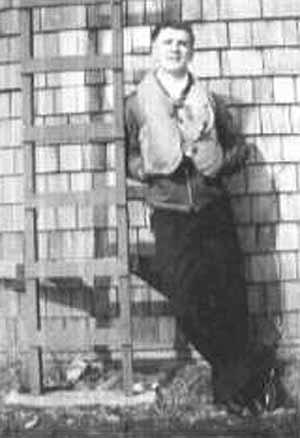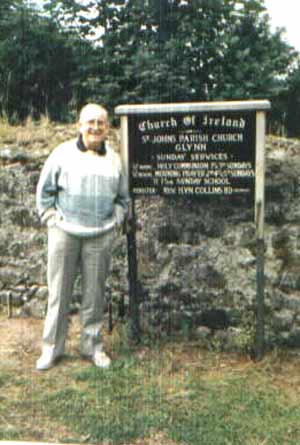

copyright © Wartime Heritage Association
Website hosting courtesy of Register.com - a web.com company
Wartime Heritage
ASSOCIATION
Remembering the Telegraphist Air Gunners

A Brother’s Memory
Remembering Petty Officer Bernard Glynn Howe (Telegraphist Air Gunner)
Glynn was my older brother (by two years). Like most boys growing up during the Second World War, his great ambition was to take
part in the “fight-back”. This feeling became even more intense after our family home was badly damaged in November 1940 during
the bombing of Coventry. At the time he was 15 years old.
Although not old enough to “Join Up”, he felt he must do what he could to prepare
himself for the fight ahead. One must remember that, after the Dunkirk episode,
Winston Churchill was rallying us all to prepare to “Fight them on the Beaches, etc.”
Boys between the ages of 15 and 17 were encouraged to join either the Army cadets
or the Air Training Corps. Glynn chose the ATC.
In the early stages of its development the ATC was rather a “hotch-pot” of an
organisation, at least it was in our rather gentile town of Royal Leamington Spa,
which is right in the centre of England! However, First World War Veterans, School-
masters and like volunteers were rounded up to teach these boys such things as
military discipline, mathematics, Morse code, map reading, etc. This training,
combined with occasional visits to RAF Stations, with the prospect with seeing real
aeroplanes and, maybe getting a flight, worked wonders with these young
“recruits”. One must also remember that this was a period of great austerity, with U
Boat submarines taking a terrible toll of our merchant shipping. Food, fuel and
clothing were severely rationed. Eventually, the Air Ministry was able to find a
complete uniform for each cadet!
Very few fitted perfectly, but doting mothers soon got busy with their sewing
machines.
Glynn was always good at Maths, English and Shorthand, his Dad had been a signaller
in World War 1 and was able to practice Morse code with him. As a result, he made fast promotion in the ATC eventually becoming a
Flight Sergeant.
At the age of 17 he volunteered for service with the Fleet Air Arm and, as soon as he was 18 he was told to report to “HMS Royal
Arthur”. “Royal Arthur” turned out to be a wooden hutted pre-war Holiday Camp at Skegness-on-Sea, on the east coast of England. In
the summer, Skegness is probably a very pleasant place to live. It has miles of sandy beaches and nothing but the North Sea until you
reach mainland Europe! Glynn arrived there on a bitterly cold winter’s day. He was issued with a Naval Greatcoat, Sailor’s cap, had a
full medical examination and was told that the men in his hut were on Fire-watch duty that night! There watch position was on the
highest point – the flat roof of the only brick building.
Where else would one scan the sight for incendiary bombs?! Two hours “on” and two hours “off” duty, all night. Groups worked in
pairs, each pair had a whistle, to sound as an alarm! Not a very auspicious welcome to life on the ocean wave.
However, things did improve. HMS Royal Arthur turned out to be an Initial Assessment Depot where recruits were checked over
before dispersal to more appropriate training units. All recruits were also issued with standard Naval Uniform, with money belt,
inflatable life-belt, a hammock, mattress, spare canvas mattress covers, clothes brushes, shoe brushes, boot blacking and even a
tooth brush. This was the way “Their Lords of the Admiralty” had always sent a sailor to sea so why change the system now?
Glynn soon discovered that this new kit had to be stored in a huge new canvas kit bag. Not only was it to be stored in this cavernous
receptacle, regulations decreed how each item should be folded. He soon learned that sailors’ bell-bottomed trousers needed to be
turned inside out and each leg was given seven equidistant folds! “Remember”, said the kit instructor, “there’s seven seas in the
world and your trousers must show it, not more and not less”. Those young men must have wondered why they had volunteered to
join this strange new existence.
In fact there is a very sound reason for all this peculiar equipment folding and storage but at the time it seemed rather bizarre, to say
the least.
After a couple of weeks or so, his intake was transferred to the Fleet Air Arm barracks at Lee-on–Solent, on the south coast of
England. Life at Lee, known as “HMS Daedalus”, was very disciplined.
These young men were taught how to march, drill, fire a Lee Enfield rifle, throw a live grenade, without blowing-up themselves or
their shipmates. There was daily physical education, assault courses to be mastered, wireless telegraphy to be learned and much,
much more. All this activity was monitored by their officers. Those who made the grade were selected for further flying training.
Those who didn’t, were transferred to other branches of the Royal Navy.
Glynn was full of pride. He, and several of his close mates had made the grade. What was more, they had been allocated places on
the training draft to Yarmouth, Nova Scotia. After all the privations of war-torn Britain, word had it that Canada was a land flowing of
milk and honey! Perhaps it was an exaggeration, but at least you got enough to eat and the girls were quite friendly! He was sent
home for seven days leave, to tidy up his affairs, and prepare for the “Great unknown”.
Not much is known of the journey across the Atlantic, other than it was decidedly uncomfortable. Letters home tended to be brief
telegram like epistles, which were micro-filmed, to save space and weight and then enlarged before being sent to the addressee.
Furthermore, they had to be very discrete to get passed by the censors who read specimens of all mail that might be useful to the
enemy!
Glynn and I had devised a “secret” code which he would use to let me know that he was likely to be coming back to England. It
was perfectly simple. We agreed that he would wish me a “Happy Birthday” for the date of his move. No one else would know
that it wasn’t my birthday, particularly the Nazis!
What a home-coming it was when he eventually got leave in 1944. I remember it well, even though it was 60 years ago. Not only was
he fit and well, he was laden with presents which we had not seen for the last five years. I had never owned a watch, yet I was given
this, to me, magnificent “Active Service” wrist watch. It had luminous paint on the hands and hours and was water resistant! The
watch is still in my possession – and it still works, although the face has clouded somewhat. Mother was very embarrassed, she was
given her very first pair of silk pants matched with one of these “new fangled”
garments called a `brassiere`.
The story is that his mother didn't know what name to choose when he was born so
she named him after the village ... although, Glynn used to say that the village was
named after him.
Dad was given a beautiful new shirt, with a collar attached. Furthermore, the shirt
had buttons from top to bottom. Up to that time, men’s shirts had three button
holes and were drawn over the head to be put on. Each shirt had a front and back
stud hole. One would push in the stud and to it attach the collar. No self respecting
Englishman would be seen out without a collar and tie! At least, not in the 1940s.
Collars were changed daily, shirts about twice a week!
There were also bars of chocolates and sweets in silver paper tubes! The weekly
ration of sweets, for civilians at that time, was 3 ounces, butter was 2 ounces and
sugar 4 ounces.
At that time, although I had left school and started work in the offices of the local
Council, I was required to “do my bit” on two nights a week as a Dispatch Rider at
the Air Raid Precautions Control Centre. I had been taught how to ride a motor cycle
and was part of a team who escorted ambulances carrying wounded civilians and
troops from the local railway depot to various hospitals in my area. Just my luck, on
Glynn’s first night home, I was on duty. Never mind, for the next week he was able to regale me with tales of the unbelievable
reception he and his ship mates had been given during his training in Canada.
One such story recalled the time when he was travelling to or from Edmonton. When the train got to the spot he and his friend
wanted, they got off. No one seemed to be about. Eventually they asked a man for directions. He enquired how they had got there.
“We traveled on the Trans-continental Express”, they explained. Only to be told that it doesn’t stop here. In other words, an express
train had made a special stop for two young English sailors! Where else would that have happened in the middle of wartime?
I can now understand why the TAG members and their families have such an enduring fondness for their Canadian hosts.
[Memories as recounted by Gerry Howe (brother of TAG Glynn Howe.) Gerry also joined his brother in the Fleet Air Arm but as an Air
Mechanic (E). He was never fortunate enough to be stationed in Canada.]




- World War I - Menu
- WWI Stories and Articles
- Photos - Yarmouth Soldiers
- Selection of World War I Songs
- WWI Casualties of Yarmouth, NS
- Those Who Served - Yarmouth, NS
- WWI Casualties Digby Co. NS
- WWI Casualties Shelburne Co. NS
- Merchant Mariners (1915) Yarmouth, NS
- Canadian Forestry Corps - Non Yarmouth Birth/Residence Enlistments
- US Draft Registry - Yarmouth NS Born


- World War II - Menu
- WWII Stories and Articles
- Telegraphist Air Gunners
- WWII Casualties of Nova Scotia
- US Casualties with NS Connection
- Far East/Pacific Casualties with NS Connection
- Merchant Navy Casualties Nova Scotia
- Nova Scotia WWII Casualties Holten Canadian War Cemetery
- D-Day Casualties - Nova Scotia
- CANLOAN Program Casualties - Nova Scotia
- Battle of the Bulge Casualties - Nova Scotia
- WWII Casualties Yarmouth NS
- Yarmouth Casualties - RCAF RAF Canadian Army WWII
- Yarmouth Co., Marrages WWII
- Casualties Non-Born/Residents with Connection to Yarmouth Co., Nova Scotia.
- WWII Casualties Digby Co., NS
- Non-Nova Scotian WWII Casualties Buried in Nova Scotia
- WWII RCAF Casualties Aged 16-18
- Brothers/Sisters Who Served - World War II













